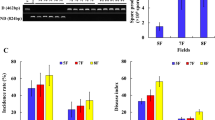Abstract
Bt cotton was the first genetically modified crop approved for use in India. However, only a few studies have been conducted to assess the feasibility of its commercial application. Bt cotton is genetically modified to express a proteinaceous endotoxin (Cry) encoded by cry gene of Bacillus thuringiensis that has specific insecticidal activity against bollworms. Therefore, the amount of pesticides used for growing Bt cotton is postulated to be considerably low as compared to their non-Bt counterparts. Alternatively, it is also speculated that application of a genetically modified crop may alter the bio-geochemical balance of the agriculture field(s). Microbial community composition and dynamics is an important descriptor for assessment of such alterations. In the present study, we have assessed the culturable and non-culturable microbial diversities in Bt cotton and non-Bt cotton soils to determine the ecological consequences of application of Bt cotton. The analyses of microbial community structures indicated that cropping of Bt cotton did not adversely affect the diversity of the microbial communities.

Similar content being viewed by others
References
Abdo Z, Schüette UM, Bent SJ et al (2006) Statistical methods for characterizing diversity of microbial communities by analysis of terminal restriction fragment length polymorphisms of 16S rRNA genes. Environ Microbiol 8:929–938
Bambawale OM, Singh A, Sharma OP et al (2004) Performance of Bt cotton (MECH-162) under Integrated Pest Management in farmers’ participatory field trial in Nanded district, Central India. Curr Sci 86:1628–1633
Dahllof I (2002) Molecular community analysis of the microbial diversity. Curr Opin Biotechnol 140:82–87
DeLong EF, Pace NR (2001) Environmental diversity of bacteria and archaea. Syst Biol 50:470–478
Dunbar J, Ticknor LO, Kuske CR (2000) Assessment of microbial diversity in four southwestern United States soils by 16S rRNA gene terminal restriction fragment length analysis. Appl Environ Microbiol 66:2943–2950
Dunfield KE, Germida JJ (2003) Seasonal changes in the rhizosphere microbial communities associated with field-grown genetically modified canola (Brassica napus). Appl Environ Microbiol 69:7310–7318
Dunfield KE, Germida JJ (2004) Impact of genetically modified crops on soil- and plant-associated microbial communities. J Environ Qual 33:806–815
Engebretson JJ, Moyer CL (2003) Fidelity of select restriction endonucleases in determining microbial diversity by terminal-restriction fragment length polymorphism. Appl Environ Microbiol 69:4823–4829
Estruch JJ, Carozzi NB, Desai N et al (1997) Transgenic plants: an emerging approach to pest control. Nat Biotechnol 15:137–141
Franklin RB, Mills AL (2003) Multi-scale variation in spatial heterogeneity for microbial community structure in an eastern Virginia agricultural field. FEMS Microbiol Ecol 44:335–346
Giovannetti M (2003) The ecological risks of transgenic plants. Biol Forum 96:207–224
Hofte H, Whiteley HR (1989) Insecticidal crystal protein of Bacillus thuringiensis. Microbiol Rev 53:242–255
LeBlanc PM, Hamelin RC, Filion M (2007) Alteration of soil rhizosphere communities following genetic transformation of white spruce. Appl Environ Microbiol 73:4128–4134
McGaughey WH, Gould F, Gelernter W (1998) Bt resistance management. Nat Biotechnol 16:144–146
O’Callaghan M, Glare TR, Burgess EP, Malone LA (2005) Effects of plants genetically modified for insect resistance on non-target organisms. Annu Rev Entomol 50:271–292
Paul D, Pandey G, Meier C et al (2006) Bacterial community structure of a pesticide-contaminated site and assessment of changes induced in community structure during bioremediation. FEMS Microbiol Ecol 57:116–127
Ranjard L, Poly F, Nazaret S (2000) Monitoring complex bacterial communities using culture-independent molecular techniques: application to soil environment. Res Microbiol 151:167–177
Romeis J, Meissle M, Bigler F (2006) Transgenic crops expressing Bacillus thuringiensis toxins and biological control. Nat Biotechnol 24:63–71
Sakamoto T, Matsuoka M (2004) Generating high-yielding varieties by genetic manipulation of plant architecture. Curr Opin Biotechnol 15:144–147
Tyson GW, Banfield JF (2005) Cultivating the uncultivated: a community genomics perspective. Trends Microbiol 13:411–415
Uzogara SG (2000) The impact of genetic modification of human food in the 21st century: a review. Biotechnol Adv 18:179–206
Wallimann T (2000) Bt toxin: assessing GM strategies. Science 287:41
Wolfenbarger LL, Phifer PR (2000) The ecological risks and benefits of genetically engineered plants. Science 290:2088–2093
Acknowledgments
We are thankful to Monsanto India Ltd. for funding the present study and to Mr. R. D. Kapoor for his suggestions during the preparation of the manuscript. We are also thankful to Dr. O. M. Bambawale, NCIPM, for providing the soil samples from the trial fields. Thanks is also extended to Mr. Dhan Prakash and Ms. Archana Chauhan for their help and assistance. This is an IMTECH communication number 038/2009.
Author information
Authors and Affiliations
Corresponding author
Electronic supplementary material
Below is the link to the electronic supplementary material.
Rights and permissions
About this article
Cite this article
Kapur, M., Bhatia, R., Pandey, G. et al. A Case Study for Assessment of Microbial Community Dynamics in Genetically Modified Bt Cotton Crop Fields. Curr Microbiol 61, 118–124 (2010). https://doi.org/10.1007/s00284-010-9585-6
Received:
Accepted:
Published:
Issue Date:
DOI: https://doi.org/10.1007/s00284-010-9585-6




